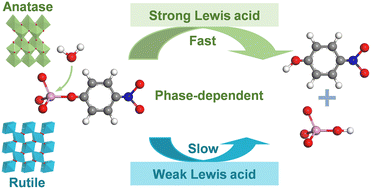Anatase TiO2 nanomaterials are much more effective in enhancing hydrolysis of organophosphorus compounds than their rutile counterparts†
Abstract
Titanium dioxide (TiO2) nanoparticles, originating from both natural and anthropogenic sources, are ubiquitous in the environment. Growing evidence shows that TiO2 can influence the fate of organic contaminants by mediating their hydrolysis reactions under environmental conditions, but some of the fundamental structure–activity relationships remain elusive. Here, we show that two anatase TiO2 nanomaterials with predominantly exposed {101} and {001} facets, respectively, are much more effective in catalyzing the acid-promoted hydrolysis of 4-nitrophenyl phosphate (pNPP, a model organophosphorus pollutant) than two rutile TiO2 nanomaterials with predominantly exposed {110} and {111} facets, respectively. Within the pH range of 5–8, the observed apparent rate constants of the two anatase nanomaterials are 2.8–27 times those of their rutile counterparts. The much higher catalytic efficiency of the anatase nanomaterials is largely attributed to the significantly stronger surface Lewis acidity of the materials. This facilitates the breaking of the P–O bond in pNPP, when the compound is bound to the surface Ti atoms via Lewis acid–base interactions. Interestingly, the exposed facet appears to play a minor role in affecting the catalytic efficiency of TiO2, as facets regulate surface Lewis acidity to a much lesser extent compared with the crystalline phase. These findings underscore the importance of further understanding the structure–effect relationship governing the environmental implications of nanomaterials.

- This article is part of the themed collections: Environmental Science: Nano Recent HOT Articles and Environmental Remediation


 Please wait while we load your content...
Please wait while we load your content...